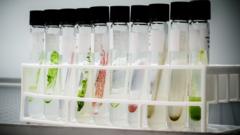What’s Next After the Ban on Artificial Food Colors?

Exploring the Future of Natural Food Dyes: The Role of Microalgae and Industry Shifts
The food industry is undergoing a significant transformation as the demand for natural food dyes grows. Traditional synthetic dyes are being phased out due to health concerns, pushing companies to seek healthier alternatives. One key player in this movement is Fermentalg, a French firm at the forefront of microalgae research. By harnessing the capabilities of microalgae, particularly Galdieria sulphuraria, Fermentalg is poised to revolutionize the way we color our food and beverages. This article delves into the implications of these changes, the science behind natural dyes, and the challenges that lie ahead for food manufacturers.
The Importance of Microalgae in Our Ecosystem
Microalgae are tiny organisms that play a crucial role in the aquatic ecosystem. They are responsible for producing approximately half of the oxygen we breathe and are the foundation of the aquatic food chain. With hundreds of thousands of species of microalgae to explore, scientists like Hywel Griffiths, chief scientific officer at Fermentalg, are venturing into diverse environments, from Caribbean volcanoes to the waters of New Zealand, in search of beneficial strains.
Microalgae are not only vital for ecological balance but also offer commercial opportunities. They are already being utilized in food production, animal feed, and fertilizers, showcasing their versatility and potential. The focus on Galdieria sulphuraria, in particular, highlights the innovative ways companies are leveraging nature's resources to create sustainable solutions.
Galdieria Blue: A New Natural Pigment
One of the standout innovations from Fermentalg is Galdieria blue, a natural pigment derived from Galdieria sulphuraria. This pigment has been approved by the US Food and Drug Administration (FDA) for use in food products, marking a significant milestone in the quest for safer, natural alternatives to synthetic dyes. Galdieria blue is expected to hit store shelves in the near future, offering a vibrant and safe coloring option for a variety of food and beverage products.
With increasing consumer awareness of health risks associated with synthetic dyes, the FDA's approval of Galdieria blue is timely. The agency has recently taken steps to phase out several artificial dyes, including Red Dye No. 3 and petroleum-based synthetic dyes, as part of a broader initiative to promote healthier food options for consumers.
The Shift Away from Synthetic Dyes
The movement away from synthetic dyes in the food industry is gaining momentum. The FDA's announcement to ban Red Dye No. 3 and phase out other synthetic colors by 2026 was driven by concerns over the long-term health effects of these additives. FDA Commissioner Marty Makary highlighted the urgency of addressing the toxic exposure that many American children have faced for decades.
As more consumers advocate for transparency in food labeling and healthier options, food manufacturers are feeling the pressure to reformulate their products. Many companies, including industry giants like Nestle and Kraft Heinz, have committed to eliminating artificial colors from their products, recognizing the need to adapt to changing consumer preferences.
Natural Alternatives: Challenges and Solutions
While the transition to natural colors presents a promising future, it is not without its challenges. One major hurdle is achieving the stability and vibrancy of natural dyes that consumers expect. Natural colors often have a shorter shelf life compared to their synthetic counterparts, which can lead to complications in production and distribution.
Fermentalg has encountered similar challenges in its quest to produce Galdieria blue. The company found that the growing conditions and extraction methods used can significantly impact the stability and quality of the pigment. This highlights the importance of refining the production process to ensure that natural dyes meet the expectations of manufacturers and consumers alike.
The Financial Implications of Natural Dyes
One common concern regarding the shift to natural colors is the potential increase in production costs. While natural dyes may initially be more expensive, their impact on the final product is relatively minor. As Mr. Griffiths from Fermentalg points out, these colors are used in minute quantities, making their overall contribution to the product's cost less significant than one might assume.
Furthermore, the long-term benefits of using natural dyes, including consumer trust and brand integrity, can outweigh the initial cost increase. As companies move toward more sustainable practices, they may find that consumers are willing to pay a premium for products that align with their values, including health and environmental concerns.
Industry Adaptation: Reformulating Recipes
The transition away from synthetic dyes has prompted many companies to rethink their product formulations. For instance, WK Kellogg has announced plans to reformulate its cereals to exclude FD&C colors by the 2026-27 school year, responding to consumer demand for cleaner labels and healthier options. This shift is indicative of a broader trend within the food industry as brands seek to remain competitive and relevant in an evolving marketplace.
The challenges associated with reformulating recipes are significant, particularly for companies reliant on synthetic colors. Achieving the same vividness and stability with natural alternatives requires innovation and careful planning. Food technologists are working diligently to ensure that natural colors meet consumer expectations without compromising product quality.
Future Outlook: The Role of Natural Dyes
Looking ahead, the future of natural food dyes appears promising. As more companies embrace the shift away from synthetic options, the market for natural colors is likely to expand. This presents opportunities for innovative firms like Fermentalg to lead the way, providing high-quality, sustainable alternatives that meet consumer demands.
As the industry adapts to these changes, it is essential to consider the long-term implications for health, sustainability, and consumer trust. The push for natural colors aligns with a broader movement toward transparency in food production and labeling, reflecting changing consumer priorities in the modern marketplace.
Frequently Asked Questions (FAQs)
What are microalgae, and why are they important?
Microalgae are microscopic organisms primarily found in water. They play a crucial role in the aquatic food chain and produce a significant portion of the Earth's oxygen. Their potential for commercial use in food and other products is being increasingly recognized.
What is Galdieria blue, and how is it produced?
Galdieria blue is a natural pigment derived from the microalgae Galdieria sulphuraria. It is produced through a cultivation process that optimizes conditions for pigment production, followed by extraction and purification methods to ensure quality and stability.
Why is the food industry moving away from synthetic dyes?
The food industry is transitioning away from synthetic dyes due to health concerns and consumer demand for natural ingredients. Regulatory changes, including FDA announcements to phase out certain artificial colors, are also driving this shift.
What challenges do companies face when switching to natural dyes?
Companies face challenges such as achieving the desired color vibrancy and stability, managing shorter shelf lives of natural dyes, and reformulating recipes while maintaining product quality and consumer satisfaction.
As we witness the food industry evolve, the potential of natural dyes derived from microalgae stands as a beacon of innovation. What are your thoughts on the shift towards natural food coloring? Could this change reshape the way we perceive and consume our food? #NaturalDyes #FoodInnovation #SustainableEating
Published: 2025-07-24 23:10:08 | Category: technology



